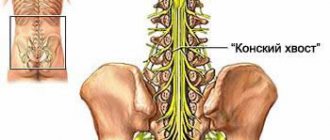Why is the ischial fiber pinched?
Nerve entrapment occurs due to weakness of the back muscles and misalignment of the vertebrae.
Common factors for lower back pinching during pregnancy include:
- exacerbation or resumption of pathologies that the woman suffered from before bearing the child;
- intense enlargement of the uterus, multiple births or polyhydramnios;
- excessive excess weight, leading to displacement of the spinal disc - in this case, compression occurs not only of large nerves, but also of small spinal roots;
- increased pressure due to a large fetus and a growing uterus - compression occurs in the area where the tube exits the spine.
Most often, a situation arises when hidden disorders of the musculoskeletal system are revealed during pregnancy. The mechanism of infringement is triggered by the following pathologies: injuries and fractures of the past, spinal hernias, osteochondrosis and inflammation of the pelvic organs. Diabetes, tumors and blood clots in large vessels can trigger the disorder. Metabolic pathologies also affect the girl’s general well-being and nervous system.
If pathological provoking factors are present, pinching occurs even in the early stages. If the cause is related only to pregnancy, pain appears only at the end of the 2nd – beginning of the 3rd trimester.
Lower back pain during pregnancy: what to do?
Often during pregnancy, the expectant mother experiences pain in the lumbar spine. This is primarily due to a growing belly and increasing stress on the spine, but there are other reasons why lower back pain may occur.
Let's talk about this in more detail.
During pregnancy, lower back pain can be both physiological and pathological.
First of all, these may be normal processes of adaptation of the musculoskeletal system to the upcoming birth, but there may also be exacerbations of the mother’s chronic diseases, such as pyelonephritis (inflammation of the kidneys), osteochondrosis, scoliosis, etc. And here (ATTENTION!) only a doctor will help you understand the causes of pain, and not girlfriends “who had the exact same thing.”
Physiologically, during pregnancy, the entire ligamentous apparatus is prepared for childbirth. The hormone RELAXIN is produced in the ovaries and placenta, under the influence of which the connective tissue becomes more extensible and loose. This is necessary so that during childbirth the pelvic bones become more mobile and make it possible to give birth to a child through a tight pelvic ring. These changes can cause lower back pain.
Typically, such pain appears from 20 weeks of pregnancy (5 months) and decreases or disappears only after childbirth. A DIET rich in calcium partly helps to cope with them. Be sure to include dairy products, nuts, fish, meat, and greens in your diet.
In addition, there are some practical tips recommended for all pregnant women.
So, AVOID:
- sudden movements;
- standing on your feet for a long time;
- incorrect postures when sitting;
- excessive physical activity;
- uncomfortable shoes with high and/or unstable heels.
For diseases of the spine (osteochondrosis, scoliosis, herniated discs), SPECIAL GYMNASTICS aimed at strengthening the muscles of the back, abdomen, hips and buttocks can also help. Aerobics, aqua aerobics, and swimming are recommended. A CORRECTLY SELECTED BANDAGE and non-drug treatment methods, such as MASSAGE, will also help, since the drugs that are usually used to treat these diseases are contraindicated during pregnancy.
For pain associated with diseases of the spine, CONSULTATION WITH A NEUROLOGIST IS REQUIRED.
If the pain in the lower back is aching (pulling), accompanied by an increase in temperature, the appearance of edema, frequent urination, headache, change in the color of urine, increased blood pressure, then it is necessary to conduct examinations of the urinary system - the bladder and kidneys. With renal colic, the pain is sharp, cramping, and the urine may be mixed with blood. To establish an accurate diagnosis, ADDITIONAL STUDIES are carried out: ultrasound, laboratory tests of blood and urine. To treat inflammatory processes in the kidneys, antibiotic therapy is prescribed, taking into account the sensitivity of the microorganism to the antibiotic.
Treatment must be carried out in a hospital setting under the supervision of a doctor, because These diseases affect the condition of the fetus, the course of pregnancy and the health of the woman.
In addition to all of the above, pain in the lumbar spine may be one of the signs of a threatened miscarriage. More often, such pain is also accompanied by pain in the lower abdomen. In such a situation, it is necessary to urgently CONTACT AN OB/GYNECOLOGIST for an examination and to decide on the tactics of further action, which should be aimed at relieving the tone of the smooth muscles of the uterus.
If you notice such signs before 37 weeks of pregnancy and there is discharge from the genital tract, if pain is felt in the lower abdomen, and the intervals between these pains are reduced, then you should urgently seek medical help, this may indicate a threat of miscarriage.
At later stages, pain in the sacral area may be the first sign of labor that has begun.
Be healthy, take care of yourself and your unborn baby!
about the author
- Sytova Valentina Ivanovna
- Obstetrician-gynecologist of the first category
- All publications by the author
Symptoms of pinched spinal nerves
Pinching of the sciatic nerve is manifested by pain in the lower back and leg.
In 90% of cases, the sciatic fiber, located closest to the uterus and internal organs in places of strong compression by the fetus, is pinched in the back during pregnancy. This condition can be suspected based on a number of additional signs. Only in exceptional cases does a woman feel nothing for a long time.
The nature of the pain is one-sided, located first in the lower back, then down to the tailbone and left or right leg. Since the ending is divided into 2 large rods, one of them is pinched. Other signs include:
- lumbago along the entire length of the nerve, pulsations in some areas;
- the symptom constantly changes location - it may hurt in the back, then in the thigh or lower;
- numbness of the toes and subsequent changes in gait are observed both with and without pain;
- burning, tingling and nagging discomfort from the affected nerve;
- it is difficult for a woman to get up from a sitting position or roll over from side to side;
- problems with the functioning of the bladder and intestines.
Sometimes patients develop a fever. Pinching of the sciatic nerve can be accompanied by both sharp and subtle symptoms.
If the pain becomes unbearable and is localized in the lower back, you should consult a doctor. This condition is sometimes associated with strangulation or damage to the kidney. The patient cannot move with this disorder. You should also visit a doctor if you experience fecal or urinary incontinence.
How to treat?
Any treatment during pregnancy requires special caution. When prescribing certain treatment methods, the doctor must assess the expected benefit to the mother and the possible risk to the fetus. If it is possible to postpone treatment until the postpartum period, then this path is chosen. If the painful condition of a pregnant woman prevents her from moving normally, resting, or she is tormented by unbearable pain, then a course of treatment is necessary. For help in treating sciatica, as well as many other diseases, including during pregnancy, you can contact qualified specialists at the Energo clinic.
Exercise therapy and gymnastics
With the help of physical therapy and special gymnastics, you can fight various neurological diseases, including sciatica. The doctor should prescribe specific types of exercises to perform after assessing the patient’s general condition. Basically, each exercise is aimed at strengthening the back muscles. One of these exercises is arching the back from a starting position on all fours (the so-called “cat”).
Massage
Massage for a pinched sciatic nerve allows you to relieve tension from the muscles, increase their tone, improve the patient’s general condition, improve blood flow and metabolism. It can only be done when there are no acute attacks of pain. This applies not only to pregnancy, but also to the general purpose of massage for pinched sciatic nerves.
Warming up
To eliminate pain, you can use a warming procedure. For this you can use, for example, a belt made of dog hair, pads with buckwheat or flaxseed and other coolants.
Yoga
Calm, relaxing yoga classes help restore emotional balance, relieve muscle tension, and increase muscle tone. After yoga, many pregnant women notice that their general health improves, their mood improves, and their appetite is restored, which, of course, has a positive effect on the development of the fetus.
Manual therapy
Manual therapy helps relieve pain and reduce its attacks. The impact occurs on certain points on the back and legs where the pain is localized.
Compresses
For compresses and rubbing, you can use tinctures of medicinal herbs. This must be done with great caution, following the clear instructions of the doctor, since almost all such tinctures contain alcohol. You also need to remember that in the presence of an inflammatory process in the body or elevated temperature, compresses are contraindicated.
Prenatal bandage
To reduce the load on the spine and maintain it in the correct position, pregnant women are recommended to wear a prenatal bandage. Doctors usually recommend wearing it from the middle of the second trimester. You don't need to wear it all day - about 2-3 hours. It is easier to walk or stand in a brace. It may be uncomfortable to sit and rest in it.
Drug treatment
Drug treatment during pregnancy is rarely used. Most drugs have a number of contraindications in their descriptions, which almost always include pregnancy (especially the 1st and 3rd trimesters). In extreme cases, painkillers, B vitamins, and anti-inflammatory drugs may be prescribed.
Danger to mother and child
In the later stages, pinching of the sciatic nerve can lead to premature birth.
Pinching of the nerve ending in the early stages often leads to termination of pregnancy. This is due to sudden contractions of the uterus. In the later stages, it can cause premature birth. In the long term, this condition worsens the mother's health after pregnancy.
In some cases, acute pain that persists until delivery leads to complications during the delivery of the baby. If necrosis of surrounding tissues develops in the affected area, the fetus is in danger due to lack of nutrition.
Among the long-term prospects for a woman’s life:
- spine pathologies;
- immobility or local loss of sensation in the leg;
- disability;
- preservation of involuntary excretion of feces and urine.
To avoid these conditions, it is important to undergo a complete examination before planning a pregnancy. Diagnostic procedures will help to find hidden diseases and cure them before pregnancy. Otherwise, the consequences can be dangerous.
Symptoms
The disease makes you feel the whole range of possible pain sensations: from burning and aching to shooting and sore. The nature of the pain syndrome is unstable, the pain can subside and suddenly intensify, intensifying with any muscle tension. Pain appears along the sciatic nerve, moving to the buttock area. The following signs are added to it:
- swelling in the lumbar region;
- increased body temperature;
- numbness in the legs or pelvis;
- leg weakness;
- incontinence.
Depending on the cause, the pathology can develop at different rates and be characterized by different pain sensations.
In addition to pain, a clear sign of sciatica is paresthesia - a type of sensitivity disorder in which there is a sudden sensation of burning, pins and needles and tingling.
What to do if your back gets pinched
From the very beginning of pregnancy, it is recommended to do yoga and breathing exercises.
If a violation does occur, it must be dealt with immediately after its appearance. Recommendations:
- Medicines should not be taken before consulting a doctor;
- you can use herbal preparations;
- You should call your doctor immediately after a symptom occurs;
- To avoid worsening the condition, you should avoid heavy lifting and excessive activity.
And to prevent unpleasant health, you need to wear a support bandage, do exercises, do yoga or other physical exercise for pregnant women.
Treatment tactics
Of the painkillers, it is allowed to take No-Shpu.
In the early stages of pregnancy, you can use some medications, but in the later stages you need to give up almost all medications. This is due to the fact that the protective placenta becomes very thin and permeable before the approaching birth.
For therapy, ibuprofen and paracetamol are usually used in minimal dosages. Sometimes compresses are made with lidocaine, which is indicated in late pregnancy. “No-shpu” is prescribed if there are spasms and hypertonicity.
To prevent such conditions, it is useful for women to drink vitamins: B, E, potassium and magnesium. They are included in complex supplements for pregnant women. Insufficient content of these substances leads to various abnormalities in the functioning of muscle structures, ligaments and joints.
Among the pharmaceutical drugs, Menovazine is distinguished:
- use for rubbing 3 times a day;
- applied to the lower back, tailbone and buttock on the affected side;
- leave overnight, covered with a scarf or shawl.
Many women note that the drug helps after the first use.
Essential oils
Rosemary oil eliminates pain and cramps.
The use of concentrated esters is considered a safe and effective way to combat disorders during pregnancy. It is advisable to discuss their use with a gynecologist and an expert aromatherapist.
Oils are rubbed into the skin in the affected area, as well as into biologically active points:
- rosemary relieves spasms;
- lavender eliminates fear, stress and insomnia, helps with pain;
- chamomile reduces inflammation;
- mint and eucalyptus fight negative reactions and eliminate pain.
However, their use in the first trimester is not recommended due to the increased risk of toxicosis.
Exercise therapy for infringement
You can do gymnastics after acute pain has been relieved.
You cannot do physical exercise without a doctor’s prescription. If the gynecologist has approved physical activity, the following exercises are suitable:
- Cat. Arching and bending the back while inhaling and exhaling 10-15 times, 5-10 approaches per day.
- Squats. Perform with a straight back and bent knees.
- Walking like a soldier. Without bending your legs, take 10-15 steps on your heels and then on your toes.
If a woman has not yet worn a bandage, it’s time to think about choosing one. Use it 1-2 hours a day, but not constantly.
A pinched nerve in the lower back is a condition that can be treated without harm to the child or your own health if you consult a doctor in a timely manner.










